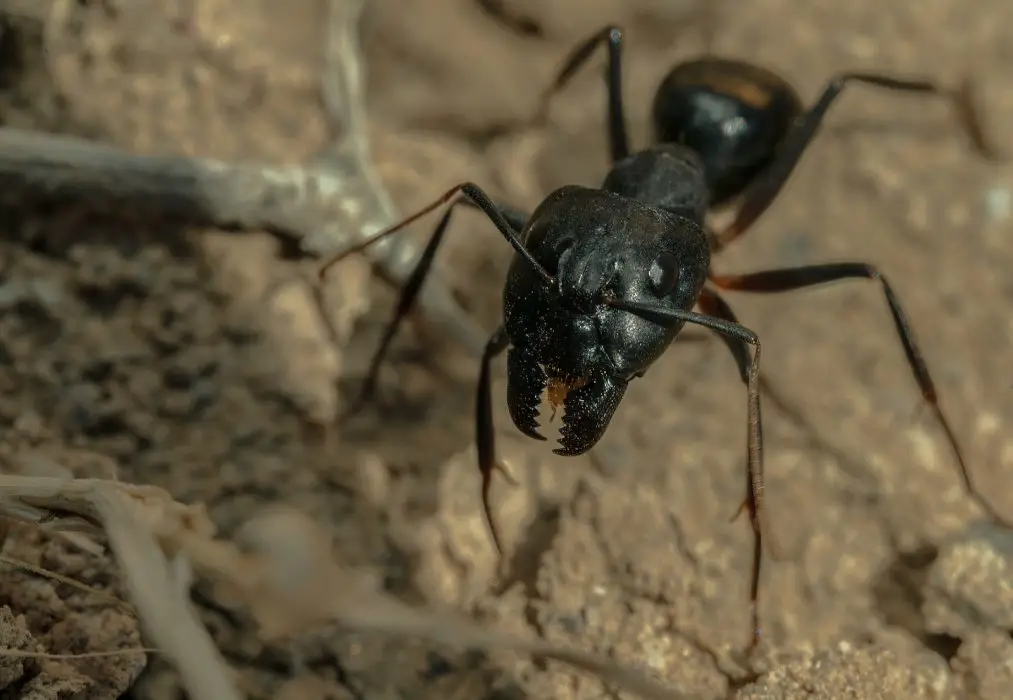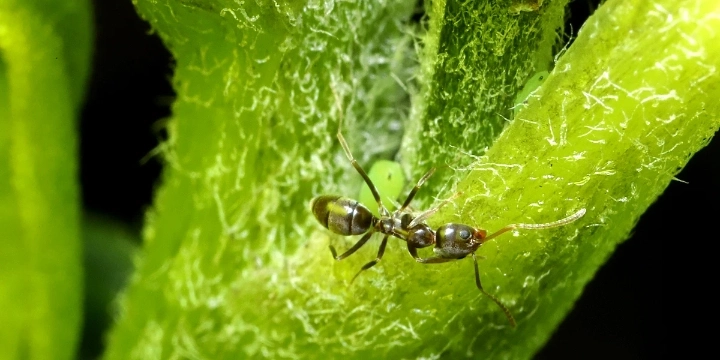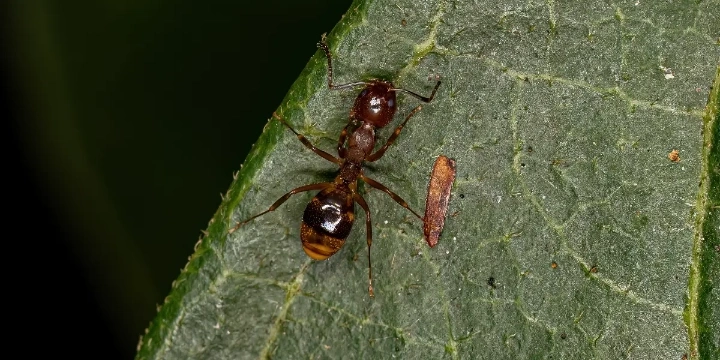Under the scorching Arizona sun, a hidden world thrives the world of ants. Ants in Arizona are tiny creatures that play a vital role in the desert ecosystem, but their story is often overlooked.
These tiny creatures have adapted to thrive in one of the harshest environments on Earth. They are a reminder that even the smallest and most seemingly insignificant creatures have an important role to play in the world.
Let’s look into the fascinating world of Arizona ants, exploring their unique adaptations, their vital role in the ecosystem, and the stories of resilience that they tell.
Types Of Ants in Arizona
Arizona hosts around 300 ant species, but only a handful are of concern when they decide to share your living space. Vigilance is crucial as certain ants can transmit diseases and deliver painful stings.
Here are some of the most common ant species in Arizona:
Carpenter Ants

Carpenter Ants are one of the largest ant species in Arizona. They are known for their ability to excavate wood to create their nests. They do not eat wood, but they do remove wood fibers to create their galleries. These galleries can weaken wood structures and cause serious damage to homes and other buildings.
- Size & Color: They can range in size from 1/4 to 1/2 inch long. They are typically black in color.
- Habitat: They establish their nests within wood, including trees and occasionally buildings, which can lead to structural concerns.
- Biodiversity: They play a pivotal role in ecosystem health by aiding in the decomposition of dead wood.
- Complexity: Their wood-boring behavior sometimes results in property damage.
Fire Ants in Arizona

Southern fire ants and desert fire ants are common pests in Arizona. They are aggressive and have a painful sting that can cause blisters. Fire ants are also difficult to kill. These invasive insects thrive in the desert state’s hot and dry climate, making their presence felt in urban areas, parks, and other outdoor spaces.
- Size & Color Fire Ants in Arizona are typically small, measuring around 1/8 to 1/4 inch, with reddish-brown to reddish-black coloration.
- Habitat: They construct mound nests in sunny, open areas, including lawns, parks, and golf courses.
- Biodiversity: They have both positive and negative impacts. They aerate the soil and control certain pests, but their presence can disrupt native insects and wildlife diversity.
- Complexity: These ants form colonies with a queen for egg-laying and worker ants for foraging and caring for the young.
Pavement Ants

Pavement Ants are a common ant species found in Arizona, particularly in urban areas. They are known for their ability to build nests in cracks in sidewalks and other paved surfaces. They can be a nuisance if they get into homes or businesses, pavement ants play an important role in the urban ecosystem
- Size & Color: Pavement Ants in Arizona are small, measuring about 1/8 inch, with reddish-brown to dark brown coloration.
- Habitat: They thrive in urban environments, making nests in sidewalk cracks, driveways, and building crevices.
- Biodiversity: While not significant disruptors, Pavement Ants may impact the local ecosystem by displacing native ant species.
- Complexity: In homes, they can be a nuisance, foraging for food and occasionally invading kitchens, requiring pest control measures
Argentine Ants

Argentine ants are a common and invasive ant species found throughout Arizona. They are known for their ability to form large colonies and their ability to adapt to a variety of habitats.
- Size & Color: Argentine Ants in Arizona are small, measuring about 1/16 to 1/8 inch, typically light to dark brown.
- Habitat: They adapt well to various environments, including urban areas, nesting in moist or dark spaces, often in close proximity to humans.
- Biodiversity: They can disrupt local ecosystems by outcompeting native ant species and protecting aphids that damage plants.
- Complexity: These ants are known for their massive colonies with multiple queens, which can make controlling them challenging.
Odorous House Ants

Odorous House Ants also known as coconut ants, are common in Arizona’s warm climate. They can be a nuisance pest, and they can also contaminate food.
- Size & Color: These Arizona ants are small, measuring around 1/16 to 1/8 inch, and they are typically dark brown to black.
- Habitat: They are often found nesting in moist areas, such as near water sources or in homes with leaks. They are also attracted to food sources, such as sugary substances and meats.
- Biodiversity: Their presence plays a role in the ecosystem by assisting in seed dispersal and preying on other insects.
- Complexity: These ants get their name from the foul odor they emit when crushed, which can be unpleasant for homeowners.
Sugar Ants in Arizona

Sugar Ants are common ants found in Arizona. They are attracted to sweet foods and can contaminate food if they get into homes .They can also be a nuisance pest, particularly if they get into large numbers.
- Size & Color These Arizona ants are small, measuring around 1/16 to 1/8 inch, and they are usually light brown to dark brown.
- Habitat: They are attracted to sugary foods and water sources, and they often nest in cracks and crevices in sidewalks, driveways, and other paved surfaces.
- Biodiversity: Their role in the ecosystem includes assisting in seed dispersal and contributing to nutrient recycling.
- Complexity: These ants are named for their attraction to sugary foods, which can lead to nuisances in kitchens and pantries.
Harvester Ants

Harvester ants, AKA seed ants, are common Arizona ants known for harvesting seeds to store in their nests. They play an important role in the ecosystem by dispersing seeds and aerating the soil.
- Size & Color: These Arizona ants are small to medium-sized, typically measuring around 1/4 to 1/2 inch, and they come in various shades of red, brown, or black.
- Habitat: Harvester ants thrive in open, sunny areas, such as deserts, grasslands, and sandy soils.
- Biodiversity: They play a significant role in the ecosystem by aerating the soil and assisting in seed dispersal, contributing to plant diversity.
- Complexity: Harvester ant colonies consist of worker ants that forage for seeds, while their large nests provide shelter and storage.
- Impact: These ants are generally not harmful to humans and coexist with the environment, occasionally forming noticeable mounds in the landscape.
Crazy Ants

Crazy ants also known as Rasberry Crazy Ant, are invasive ants that are common in Arizona. They are known for their erratic behavior and their ability to form large colonies. Crazy ants can be a nuisance pest, and they can also damage electrical equipment
- Size & Color: These Arizona ants are small, measuring around 1/8 to 1/4 inch, and have a light to dark brown coloration.
- Habitat: They can live in both moist and dry habitats. They are often found in disturbed areas, such as roadsides, parks, and agricultural fields. They can also nest in homes and buildings.
- Biodiversity: They contribute to the ecosystem by helping to decompose organic matter and acting as prey for other creatures.
- Impact: Crazy ants are generally not harmful to humans but can be a nuisance when they infiltrate homes, particularly electrical systems and appliances.
Forelius Ants

Forelius ants, aka desert ants, are tiny, hardy ants common in Arizona. Thriving in hot, dry conditions, they help control other insect populations and aerate the soil.
- Size & Color: These Arizona ants are small, measuring around 1/8 to 1/4 inch, often with light to dark brown coloration.
- Habitat: Forelius ants thrive in open, sunny areas, such as deserts and grasslands, where they nest in sandy soils.
- Biodiversity: They are essential components of Arizona’s ecosystems, contributing to soil aeration and serving as prey for various animals.
- Complexity: Forelius ants live in colonies and display complex social behaviors, including foraging and defense.
Leafcutter Ants

Leafcutter ants also known as fungus ants are found in tropical and subtropical regions, including Arizona.They harvest leaves and transport them back to their nests, where they cultivate the fungus.
- Size & Color: These ants are relatively large, measuring about 1/4 to 1/2 inch, often with a reddish-brown to black color.
- Habitat: Leafcutter ants inhabit various ecosystems, including forests and grasslands, creating intricate underground nests.
- Biodiversity: Their activities contribute to nutrient cycling in Arizona’s ecosystems and influence the plant communities.
- Complexity: Leafcutter ant colonies have an elaborate social structure with queens, workers, and soldier ants.
- Impact: Leafcutter ants aid ecological balance but can harm Arizona crops through their foraging behavior.
Pharaoh Ants

Pharaoh ants, common and fascinating insects found in Arizona, are known for their ability to form large colonies, nest in a variety of habitats, and escape detection due to their small size known for their unique characteristics:
- Size & Color: These tiny ants are about 1/16 to 1/12 inch in size and are typically yellow to light brown.
- Habitat: Pharaoh ants are often found nesting in warm, moist areas, such as inside walls, under flooring, or near hot water pipes.
- Biodiversity: Their presence can disrupt natural ecosystems, and their colonies are known for their massive numbers.
- Complexity: Pharaoh’s colonies have multiple queens, and they are notorious for being challenging to control once established in a home.
Rover Ants

Rover ants are fascinating insects commonly found in Arizona. They are known for their nomadic behavior and their ability to travel long distances in search of food and water.They are also known for their ability to nest in a variety of habitats, including deserts, grasslands, and forests.
- Size & Color: These tiny ants measure about 1/16 inch and often have a light to medium brown coloration.
- Habitat: Rover ants are versatile in their choice of nesting locations, favoring both indoor and outdoor environments.
- Biodiversity: Their colonies can be extensive, and they interact with other ant species, impacting local ant populations.
- Complexity: Rover ants exhibit a unique behavior called tandem carrying, where workers carry other ants to food sources.
Arizona Ant Bite Treatment
The most painful and dangerous ant bites in Arizona are from fire ants .Other ants in Arizona that can bite include harvester ants, sugar ants, and crazy ants. Bites from these ants are typically not as painful or dangerous as fire ant bites, but they can still cause discomfort and itching.
Here are four tips for treating ant bites:
- Wash the bite with soap and water.
- Apply a cold compress to the bite to reduce swelling and pain.
- Take an over-the-counter antihistamine, such as diphenhydramine (Benadryl), to relieve itching.
- Keep the bite clean and dry.
How to Get Rid of Ants in Arizona
To eliminate ants in Arizona, locate their entry points, clean surfaces, use ant baits or natural remedies, maintain cleanliness, and seal cracks. Professional pest control may be necessary for severe infestations.
Conclusion
In the arid landscapes of Arizona, the world of ants unfolds, from the resilient Carpenter Ants to the adaptable Rover Ants. While they play essential roles in the ecosystem, some, like Fire Ants and Argentine Ants, pose challenges.
Understanding their diversity and behaviors is key to peaceful coexistence. When these tiny invaders encroach upon our spaces, knowing how to treat ant bites and get rid of them becomes crucial for a harmonious desert life.



